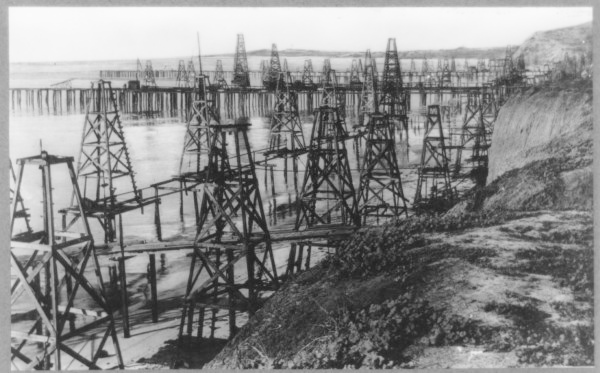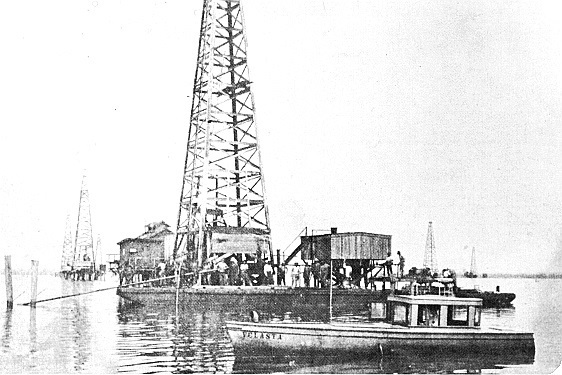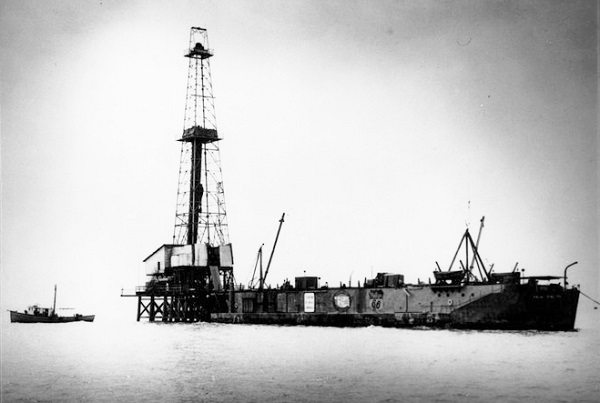The U.S. offshore petroleum industry began with drilling and production from platforms constructed on lakes in Ohio and Louisiana and on California oil piers. In Ohio, state geologists reported oil wells drilled on Grand Lake as early as 1891. Dozens of wells on Louisiana’s Caddo Lake also produced oil in 1911.
By 1897, Henry Williams had successfully pursued the giant Summerland, California, oilfield to the scenic cliffside beaches of Santa Barbara.
California Oil Piers
With reports of “tar balls” on the beaches from natural offshore oil seeps, Williams recognized that the highly productive field extended into the Pacific Ocean. He and his associates constructed a 300-foot pier, mounted a cable-tool derrick, and began drilling.

A circa 1920 view of Santa Barbara, California, beaches. “Pumping oil out of the Pacific Ocean at Summerland (oilfield)” photo courtesy Library of Congress.
When California’s first offshore oil well proved successful, more than 20 petroleum companies rushed to Santa Barbara. They constructed 14 more piers, the longest extending 1,230 feet.
Over the next five years more than 400 Summerland wells were completed as offshore and onshore drilling technologies continued to advance.
Around 1920 an unknown photographer documented “oil well derricks on the beach and in the ocean,” according to the Library of Congress Prints and Photographs Division. At the time, only a few of the historic pier wells were still active. Onshore and offshore, the Summerland oilfield would produce until 1940 and yielded more than three million of barrels of oil.
Today, Lookout Park stands over Santa Barbara beaches that annually host thousands of swimmers instead of oil piers. A park plaque commemorates the state’s early offshore petroleum pioneers as “the first offshore oil production on the western hemisphere.”
However, two other petroleum-producing states claim a similar accomplishment in production technologies.
Derricks over Lakes
“The world’s first over water oil well was completed in Caddo Lake in 1911,” proclaims a historical marker at the lake northeast of Shreveport, Louisiana. Built over water without a pier connection to shore, Gulf Refining Company’s Ferry Lake No.1 well “bottomed at 2,185 and produced 450 barrels per day,” explains the marker, erected by Gulf Oil in 1984.

A historical marker at Caddo Lake, Louisiana, erroneously claims oil wells drilled in 1911 were “the world’s first over water.” Photo courtesy Louisiana DNR.
“It has long been touted as the location of the world’s first over water oil well,” notes historian Judith Sneed of Mooringsport, Louisiana. “This accolade, however, is not correct. Stand alone oil wells produced commercial quantities of oil over a small lake in Ohio as early as 1891,” she explains. Ohio historians have documented hundreds of 1890s oil wells pumping on Grand Lake St. Marys in Mercer and Auglaize counties.
For drilling over water, enterprising oil companies constructed 14-foot-square “cribs” to support cable-tool derricks, steam engines and boilers. Pipelines carried the oil to shore from these “first” offshore wells (see Ohio Offshore Wells).
Out of Sight of Land
The pursuit of offshore oil reached another milestone in 1947. Searching for new reserves, Kerr-McGee Oil Industries pioneered offshore drilling in the Gulf of Mexico.
The company built Kermac No. 16 platform ten miles off the Louisiana shoreline – the first successful oil well out of sight of land. This success proved the feasibility of tender-serviced oil platforms at sea and opened a new era of offshore oil exploration and production.

Kermac Rig No. 16 in 1947 drilled the first offshore well out of sight of land in the Gulf of Mexico. Photo courtesy New Orleans Times-Picayune.
“Spectacular Gulf of Mexico Discovery. Possible 100-Million Barrel Field – 10 Miles at Sea,” proclaimed the Oil & Gas Journal. The Kermac No.16 well would produce 1.4 million barrels of oil and 307 million cubic feet of natural gas by 1984. Learn more in Offshore Petroleum History and Deep Sea Roughnecks.
———
The American Oil & Gas Historical Society preserves U.S. petroleum history. Please become an AOGHS supporter and help maintain this energy education website and expand historical research. For more information, contact bawells@aoghs.org. Copyright © 2025 Bruce A. Wells. All rights reserved.
Citation Information: Article Title – Offshore Oil Piers, Platforms, and Barges.” Authors: B.A. Wells and K.L. Wells. Website Name: American Oil & Gas Historical Society. URL: https://aoghs.org/offshore-history/california-oil-piers. Last Updated: July 1, 2025. Original Published Date: June 1, 2017.


